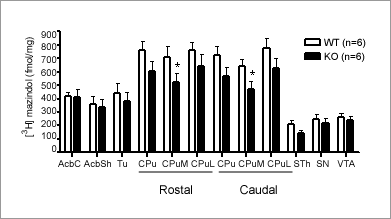Quantitative autoradiography of dopamine D1 and D2 receptors and dopamine transporter binding in the brains of triple opioid receptor knockout mice Many functional interactions have been described between the opioid and the dopaminergic systems, including co-localisation of opioid and dopamine (DA) receptors in the brain (Ambrose et al., 2006) , as well as decreases in dopamine transporters (DAT) in the striatum of morphine-tolerant rats (Gudehithlu & Bhargava, 1996) . We have previously shown that deletion of the μ-opioid (MOP) receptor gene results in only moderate changes in D1 or D2 receptors (Lena et al., 2004) . The purpose of the current study was to determine if removal of all three opioid genes coding for MOP, δ-opioid (DOP) and κ-opioid (KOP) receptors produces greater disruption of dopaminergic systems. We have carried out quantitative receptor autoradiography of D1, D2 and DAT binding in triple opioid receptor knockout (KO) and wild-type (WT) mice. Triple opioid receptor KO mice were generated as previously described (Simonin et al., 2001) . All experiments were carried out in accordance with the UK Animal (Scientific Procedures) Act 1986. Brains were removed and 20 μm coronal sections (300 μm apart) were cut for labelling of D1 receptors with [3H]SCH23390 (4 nM), D2 receptors with [3H]raclopride (4 nM) and DAT with [3H]mazindol (4 nM). Non-specific binding was determined in the presence of 10 μM cis-flupenthixol for D1, sulpiride for D2 and mazindol for DAT.
Figure 1. Quantitative autoradiography of [3H]mazindol binding in WT and triple opioid receptor KO mice ( mean ± SEM; n=6). Two-way ANOVA showed a significant effect of genotype (P<0.001) and region (P<0.001). *P<0.05 compared to WT mice (Newman-Keuls, post-hoc test). No significant differences were observed for DA D1 and D2 receptor binding between KO and WT mice (data not shown). For DAT binding, significant down-regulation was observed in KO brain, with post-hoc analysis showing this was most marked in caudate putamen (Figure. 1). Our results confirm that opioid receptor deletion does not markedly alter DA receptors but the changes in DAT binding concurs with significant decreases that have been shown in chronic naltrexone treated rats (Bhargava & Gudehithlu, 1996) . The present results provide evidence that an absence of MOP, DOP and KOP-receptors results in the modulation of the dopaminergic system via the DAT.
Ambrose, L.M. et al (2006) Neurosci Lett 399, 191-196.
This work was supported by the Korea Science and Engineering Foundation Grant (2005-215-E00003) and the European Commission (LSHM-CT2004-005166). |
|


